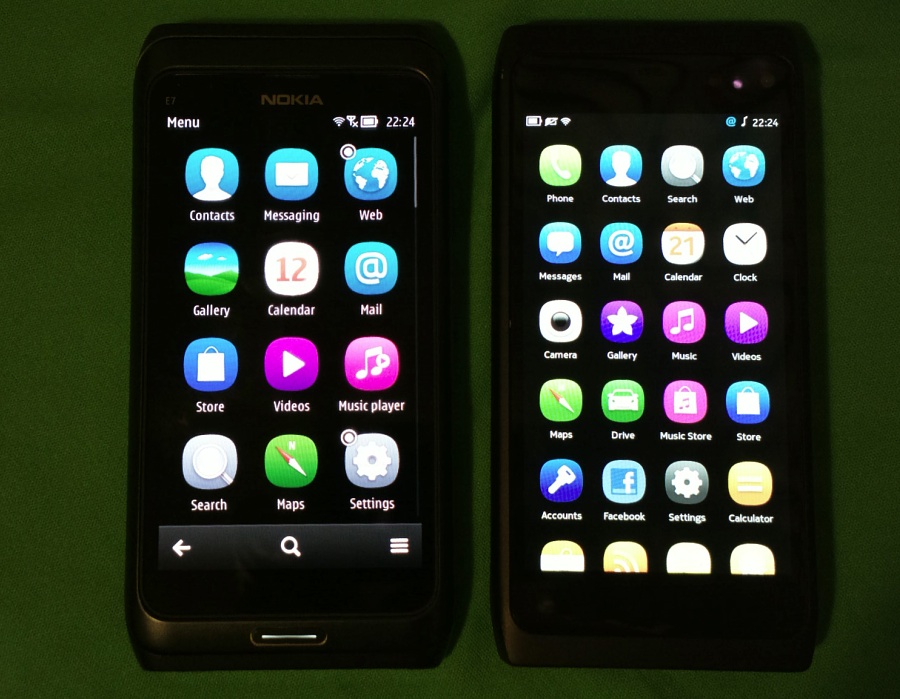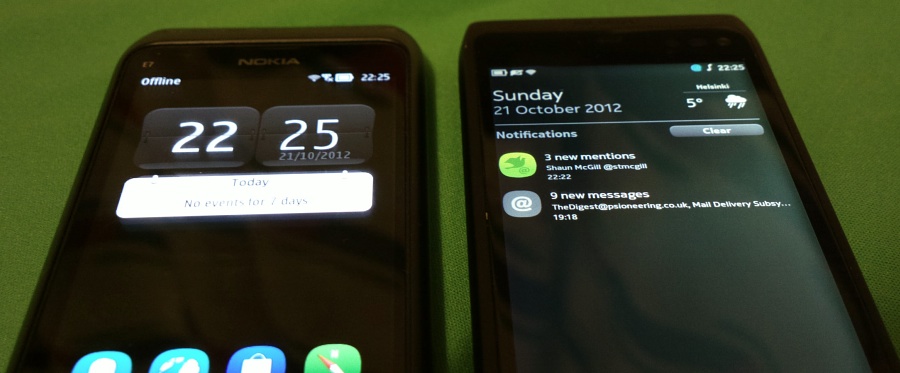| Nokia E7 | Nokia N950 | |
| Availability, history | First available December 2010, still available for sale, typical price now £280, SIM-free | Never sold, only given out to a few tens of thousand developers in summer 2011 to encourage development of Meego/N9 applications. Changes hands on the second hand market at £500+ regularly. |
| Form factor and input method, build quality | Aluminium shell with pivoting display on sturdy metal hinge. Lovely hardware, lovely form factor, incredible build quality, very thin for the keyboard size | Aluminium body with screw-on rear half (not for casual users, but easy to get off with a Torx T4 etc.), with pivoting display on sturdy metal hinge, almost identical to the E7's. Again, lovely hardware, lovely form factor, very good build quality, very thin for the keyboard size |
| Display | 4" ClearBlack Display full RGB AMOLED, pretty good in sunlight, 640 pixels by 360. Made of Gorilla Glass and almost impossible to scratch. | 4" TFT full RGB Display, 854 pixels by 480. Not sure if it's Gorilla Glass or not and not going to damage my unit testing(!) |
| Display flexibility | All OS and application screens work in both portrait and landscape modes | The interface is designed around portrait mode and the application grid, notifications and multitasking view all stay portrait. The majority of applications support display rotation to landscape, though, including obvious ones like Web, Mail and Messaging. Curiously it's done through accelerometer detection rather than a microswitch on the keyboard mechanism, so you still sometimes have to twitch the N950 up a little after opening the keyboard, to get the desired effect. |
| Keyboard | Four row keyboard, nominal key travel but excellent feel, punctuation via long key presses or Fn/Sym keys. | Almost identical to the E7's four row keyboard, nominal key travel but good feel (slightly 'harder'), punctuation via long key presses or Fn/Sym keys. |
| Touchscreen input | Features text correction (turned on in a setting) but not multitouch. Optional numeric keypad input. | Has multitouch and 'Swype' integrated, but there's no auto-correction of mispelled words - you have to tap on the suggested alternatives or (optionally) press the space bar to accept. |
| Weight | 176g | 158g. It's not at all clear why this should be lighter than the E7, but it is - can only think there's slightly less metal inside! |
| Operating system and interface | Nokia Belle Refresh (as at Autumn 2012), major firmware updates now finished. OS is mature, the raw functionality and flexibility are still class-leading (with caveats, below!) | Meego 1.2 Harmattan PR 1.3 (not officially released, but available within the developer community), the 'swipe UI' is superbly well thought out as a top level interface, the OS is fairly mature and the Qt dialogs and menus will be very familiar to Symbian users. |
| Free RAM, free user memory, expansion for apps and media | 256MB RAM, over 140MB free RAM after booting, over 300MB free on system disk, 16GB mass memory, no expansion. The absence of microSD expansion not only limits capacity, it also takes away a means of transferring media between devices. Partly to compensate for this, a USB on the go system (via supplied adapter) means that USB sticks/disks can be connected. On any desktop system, the E7's mass memory mounts via USB and can be used as any other disk for file transfer and media transfer. | 1GB RAM, 500MB free after booting, 4GB application storage, 2GB application data, 10GB user data/media storage, all managed for you by the OS - plugging into a desktop OS reveals a mass storage mode, mounting the latter disk for easy access. No microSD expansion, again, as with the E7. |
| Processor, chipset notes, peformance | ARM11, 680 MHz, plus Broadcom BCM2727 graphics acceleration, pretty quick for most (though not all) operations, full and responsive multitasking. Let down slightly by the speed of several central applications (Email and Social being perhaps the biggest culprits) | 1GHz Cortex-A8 processor, plus PowerVR GPU, everything's pretty quick, though not quite up with the speed of late 2012 Android or iOS flagships, to be honest. You can see the CPU working, but you're not left hanging around very long. Full and responsive multitasking, arguably better than Symbian's, and with the swipe UI giving easy access to anything running. |
| Camera | 8 megapixels EDoF (i.e. full focus, no macro), dual LED flash. Disappointing for business use in practice. Almost everything I'd want to capture in an office, for example, requires a degree of auto-focus. Casual snaps outdoors come out well though. | 12 megapixels auto-focus camera that's automatically downsampled slightly to 8MP (or 7MP in 16:9 mode), though I doubt there's much 'PureView-like' action going on.... Quality is pretty good, and with a vastly more flexible camera than the E7's. |
| Camcorder | Decent 720p video (EDoF excels in this use case) with excellent digital sound | Acceptable 720p video and sound, with continuous autofocus |
| Application load-out highlights (out of the box) | Nokia Maps with free navigation, Nokia Store, Quickoffice editing suite, Photo and Video editors | Nokia Maps with free navigation, Nokia Store, Photo and Video editors, Documents viewer, Wi-fi hotspot, Terminal, Galaxy on Fire 2, Need for Speed: Shift. |
| Web browsing/working on the Internet | Web as per the N97 and E90, with Flash built-in and now with multitouch support. Interface is dated and multi-stage page rendering now clumsy with 2012's bloated, multi Megabyte web pages | Rendering capabilities roughly in line with Symbian's, though also roughly twice as fast on average, so a 20 second load time on the E7 is 10s or less on the N950. |
| Messaging, Email | Nokia Mail now quite usable day to day, though rendering of rich emails can be clumsy and you're limited to just one Mail for Exchange mailbox/PIM set. | Mail is smooth and fast, support for multiple Mail for Exchange accounts. |
| Audio out | 3.5mm, plus tinny mono speaker | 3.5mm, plus even tinnier and scratchier mono speaker (though my 'review' unit may have been 'faulty' - hard to say!) |
| Battery capacity, life | 1200mAh, fixed with no user access at all (removal is a nightmare procedure that takes tens of minutes and plenty of room for messing things up), recharge each night, microUSB charging. | 1320mAh BV-4D cell (same as the Nokia 808, interestingly), in theory fixed, though replacement is only a 2 minute procedure (similar to changing the battery on the N8) by undoing 4 small Torx T4 screws on the back of the device (not that practical to do on the move though, since the screws will get lost and you also have to reset time and date after each removal etc.). Recharge needed each night, microUSB charging. |
| Connectivity notes | Quad-band GSM, Pentaband 3G, Bluetooth, Wi-Fi, GPS | Quad-band GSM, Pentaband 3G, Bluetooth, Wi-Fi, GPS |
| Video apps and capabilities | Symbian^3 video player, very slick, looks great on the big CBD display. Handles H.263/H.264/AVC MP4, plus DivX, WMV and many other formats and variants. HDMI out to compatible equipment | Adequate video playback for undemanding MP4 files, the processor struggles and gives up for most 720p content or if any advanced MP4 codec is used. |
| Application ecosystem | Quite a bit of software, including a number of good HD GPU-aware games, arguably weak area is cloud service integration apps. This is a first in my head to heads - I'm awarding the win in the ecosystem department to a Symbian handset! | A modest amount of high quality applications backed up by a very enthusiastic Maemo/Meego/N9/N950 community. |

The green 'wins' tally is 5 to 4 in favour of the N950, which feels about right, both numbers being quite low because the two devices are so similar in many ways and sometimes impossible to split.
However, the bottom line is that I really, really do want the best bits of these two superficially similar smartphones all in the one device. The N950 comes so close to being my perfect device and addresses almost every deficiency or worry in the E7, but it's completely impossible to recommend it to anyone since you can't actually buy one. Moreover, official hardware support will be non-existent, software support left in the hands of the N9/N950 community and there's precisely zero chance of any more updates (ok, the same possibly applies to the E7 as well, but let's not go there...). In fact, given that I had to manually flash on PR 1.3 (a non-trivial task, thanks Arie!), you could argue that the N950 has already gone one update beyond the last official firmware!

The tantalising dream then (this being All About Symbian!) is a Nokia N950 with Symbian on, e.g. Belle Refresh or Belle FP2. The device would be amazing and would completely deserve a return to the Communicator name. Before Maemo/MeeGo fans erupt, I should add that the N950 with MeeGo Harmattan on is also pretty terrific, very fluid and only slightly let down by the DIY nature of some of the setup and application experimentation - but then that's half the fun. Please don't ask me to choose between Symbian and Maemo/MeeGo - as you know, I love the former while I am still getting to know the latter. Suffice it to say that in terms of raw, flexible, multitasking, computing functionality they both blow iOS and Windows Phone (at version 7.5 at least) out of the water. More to the point, a 'best of both worlds' mashup, as described, would also blow much of the Android competition away too.
Oh, to have knocked the E7 and N950 design teams together back in 2010...
PS. If you're interested in what use I put the Nokia N950 to, keep an eye on The Phones Show in a few weeks time!

No hay comentarios:
Publicar un comentario